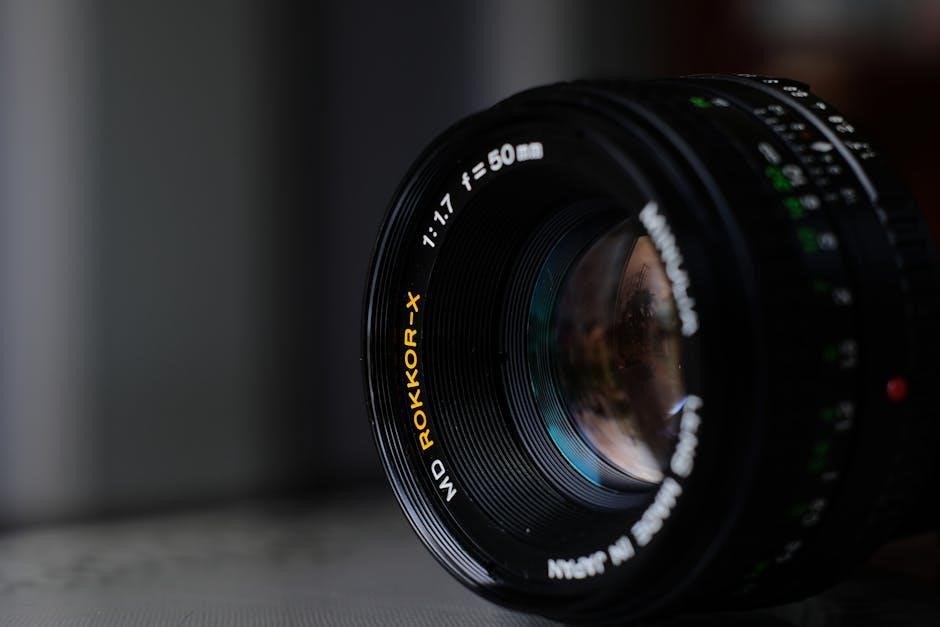The Minolta 7000 manual is your gateway to unlocking the camera’s full potential․ Discover its features‚ master functionality‚ and explore advanced settings for professional photography results․ This guide is essential for both beginners and experienced photographers‚ ensuring optimal use of the camera’s capabilities․ Dive into the detailed instructions to enhance your shooting experience and understand the camera’s intricacies․ The manual serves as a comprehensive resource‚ covering everything from basic operations to troubleshooting and maintenance․ It’s your ultimate companion for capturing stunning images with the Minolta 7000․
1․1 Overview of the Minolta 7000 Camera
The Minolta 7000 is a landmark autofocus single-lens reflex (SLR) camera‚ part of the Maxxum/Dynax series․ Known for its innovative autofocus system‚ it offers advanced film handling‚ metering modes‚ and compatibility with a wide range of lenses and accessories․ Designed for both professionals and hobbyists‚ it features intuitive controls and durability․ The camera supports multiple film-advance modes and includes a built-in flash‚ making it versatile for various shooting conditions․ Its robust construction and user-friendly interface have made it a favorite among photographers seeking reliability and creative control․
1․2 Importance of the Manual for Optimal Camera Usage
The Minolta 7000 manual is crucial for mastering the camera’s features and functions․ It provides detailed instructions on operating modes‚ lens attachment‚ and power management‚ ensuring optimal performance․ The manual guides users through troubleshooting common issues like autofocus malfunctions and exposure problems․ Additionally‚ it covers maintenance tips to extend the camera’s lifespan․ By following the manual‚ photographers can unlock the full potential of the Minolta 7000‚ enhancing their creativity and technical skills․ It serves as an indispensable resource for both beginners and experienced users‚ ensuring a seamless and rewarding photography experience․
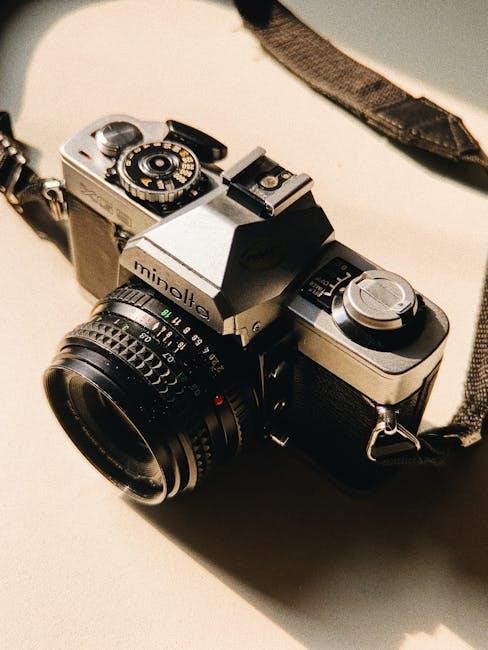
Table of Contents and Key Sections
The Minolta 7000 manual includes sections on film-advance modes‚ lens attachment‚ and camera parts․ It also covers usage basics‚ ensuring a smooth photography experience for all users;
2․1 Basics and Film-Advance Modes
The manual begins with fundamental operations‚ such as loading film and setting the ISO․ It details single-shot and continuous film-advance modes‚ explaining their applications․ The section also covers the motor drive and battery usage‚ ensuring efficient shooting․ Clear instructions guide users through basic camera handling‚ making it easy to understand and operate the Minolta 7000 effectively for various photography scenarios․
2․2 Attaching the Lens and Initial Setup
Attaching the lens involves aligning the Minolta AF mount and securing it with a gentle twist․ The manual emphasizes proper handling to avoid damage․ Initial setup includes setting the date‚ time‚ and basic camera functions․ Users are guided through configuring the camera for first use‚ ensuring all components are ready for operation․ Clear instructions help novice photographers prepare their equipment efficiently‚ while experienced users can quickly familiarize themselves with the setup process․
2․3 Camera Parts and Their Functions
The Minolta 7000 features a range of essential components designed for intuitive photography․ The mode dial allows selection of shooting modes like Manual‚ Aperture Priority‚ and Program․ The shutter button triggers capture‚ while the LCD screen displays settings and menu options․ The lens mount supports Minolta AF lenses‚ ensuring compatibility and ease of use․ Additional controls include the aperture ring‚ focus ring‚ and exposure compensation buttons․ Understanding each part’s function enhances camera operation‚ enabling photographers to make precise adjustments for optimal results․
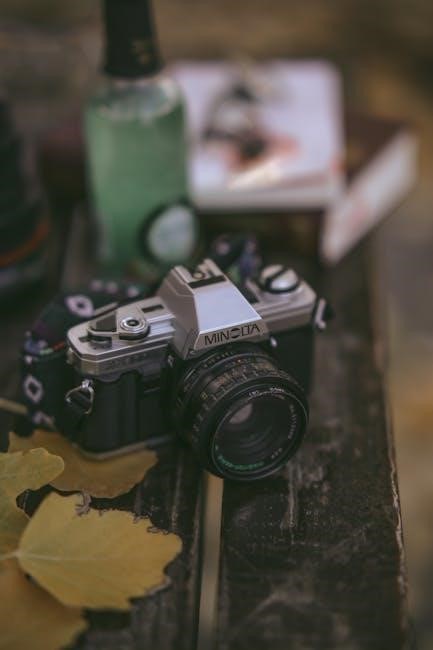
User Manual Highlights
The Minolta 7000 manual provides detailed setup guides‚ shooting mode explanations‚ and customization tips‚ helping users unlock the camera’s full potential for professional-grade photography․
3․1 Instructions for First-Time Users
For first-time users‚ the manual guides you through initial setup‚ ensuring a smooth start․ Begin by unpacking and inspecting the camera‚ then familiarize yourself with its controls․ Insert the battery‚ attach the lens‚ and load film properly․ Understand basic shooting modes and settings․ Practice focusing and metering to get comfortable with the camera’s operation․ Reading the manual thoroughly ensures you grasp all features and functions‚ helping you capture high-quality images right away․ This section is designed to build confidence and proficiency for newcomers to photography․
3․2 Loading Batteries and Power Management
Properly loading batteries is crucial for the Minolta 7000’s operation․ Locate the battery compartment‚ ensure it is clean‚ and insert the recommended 6V 2CR5 lithium battery․ Avoid mixing old and new batteries or using different types․ The camera features power-saving modes‚ such as turning off automatically after inactivity․ Always check the battery level indicator in the viewfinder to avoid sudden power loss․ The manual provides detailed steps for battery installation and troubleshooting common power-related issues‚ ensuring optimal performance and longevity of your camera․
3․3 Understanding the Camera’s Autofocus System
The Minolta 7000 features an advanced autofocus system‚ utilizing a phase-detection sensor for precise focus acquisition․ To use it effectively‚ align your subject within the AF frame and press the shutter halfway․ The camera emits a confirmation beep when focus is achieved․ For moving subjects‚ predictive AF adjusts focus based on motion․ Clean the lens regularly to ensure accurate AF performance․ The manual details how to customize AF settings and troubleshoot common issues‚ enhancing your ability to capture sharp images in various shooting conditions․
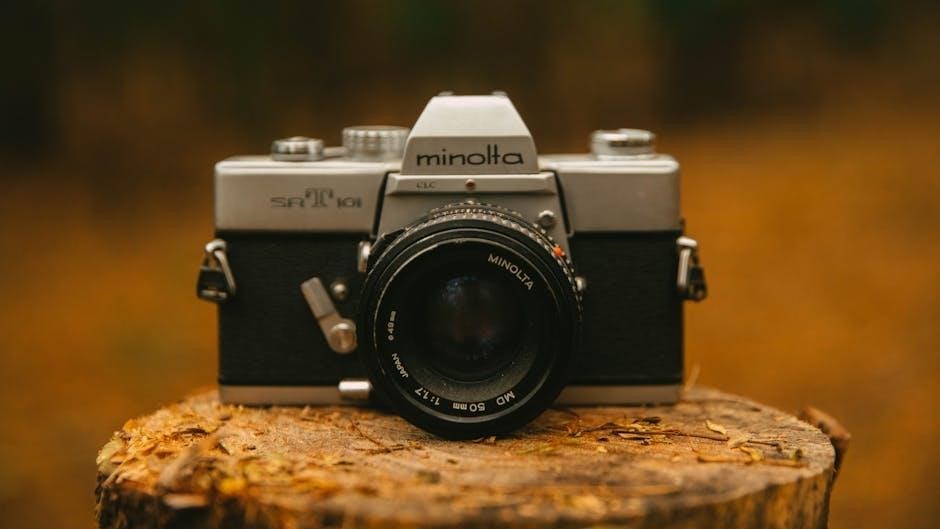
Advanced Features and Settings
The Minolta 7000 offers advanced modes like aperture priority and manual control‚ with customizable settings for ISO‚ exposure compensation‚ and metering options‚ enhancing creative control․
4․1 Metering Modes and Exposure Control
The Minolta 7000 features three metering modes: spot‚ center-weighted‚ and matrix․ Spot metering focuses on a specific area‚ while center-weighted prioritizes the central part of the frame․ Matrix metering analyzes the entire scene for balanced exposure․ Exposure control includes ±3 EV compensation and automatic bracketing for capturing multiple exposures at different settings․ These modes‚ combined with flash metering compatibility‚ allow precise control over lighting conditions‚ ensuring optimal results in various photography scenarios․ This flexibility caters to both professional and amateur photographers seeking creative freedom․
4․2 Flash and External Accessories Compatibility
The Minolta 7000 supports a range of flash units‚ including the dedicated Minolta TTL flash system‚ ensuring precise light metering․ External flashes can be mounted via the hot shoe or connected using a sync cable for off-camera lighting․ Additionally‚ the camera is compatible with other accessories like remote shutter releases and data backs‚ enhancing functionality without compromising portability․ This versatility allows photographers to expand their creative options while maintaining seamless integration with the camera’s advanced features‚ making it adaptable to diverse shooting environments and styles․
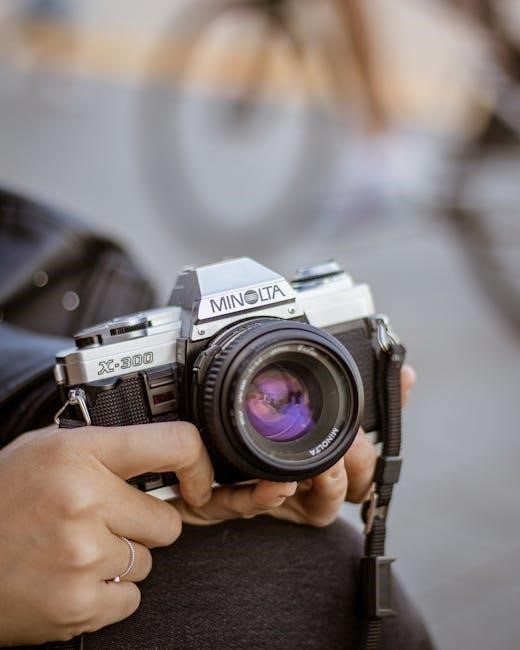
4․3 Customizing Camera Settings for Personal Preference
The Minolta 7000 offers extensive customization options‚ allowing photographers to tailor the camera to their specific needs․ Users can adjust exposure compensation‚ select from various focusing modes‚ and set custom functions to streamline their workflow․ These personalizations enable a more intuitive shooting experience‚ catering to individual preferences and enhancing creativity․ By fine-tuning settings‚ photographers can optimize the camera’s performance for different genres of photography‚ ensuring consistent and high-quality results that align with their artistic vision․
Service Manual and Technical Details
The service manual provides in-depth technical specifications‚ repair guidelines‚ and maintenance tips for the Minolta 7000․ It includes diagnostic procedures and spare parts information‚ enabling advanced users to perform professional-level servicing and upgrades‚ ensuring optimal camera performance and longevity․
5․1 Factory Service Manual Overview
The factory service manual for the Minolta 7000 offers comprehensive technical details‚ including repair procedures‚ maintenance schedules‚ and diagnostic guidelines․ It provides detailed schematics‚ parts lists‚ and troubleshooting protocols‚ enabling authorized service technicians to perform precise repairs․ The manual covers disassembly and reassembly processes‚ ensuring adherence to factory standards․ Additionally‚ it includes specifications for torque settings‚ lubrication‚ and electrical testing‚ making it an indispensable resource for professional maintenance and restoration of the camera to its original functionality and performance․
5․2 Technical Bulletins and Repair Guidelines
The Minolta 7000 manual includes technical bulletins that address specific issues and provide updated repair procedures․ These bulletins often highlight common problems‚ such as autofocus inaccuracies or exposure errors‚ and offer step-by-step solutions․ Detailed diagnostic steps and replacement part recommendations are included to ensure accurate repairs․ Additionally‚ the guidelines cover tools and techniques required for resolving complex mechanical and electrical faults‚ helping technicians restore the camera to optimal performance and maintain its reliability over time․
5․3 DIY Maintenance and Repair Tips
Regular maintenance ensures the longevity and performance of your Minolta 7000․ Clean the lens and viewfinder with a soft cloth to prevent dust buildup․ Inspect the shutter curtain for damage and replace it if necessary․ Lubricate moving parts with a small amount of grease or silicone-based lubricant․ Check battery contacts and clean them with a soft brush for reliable power․ Finally‚ gently clean the mirror and focusing screen to maintain autofocus accuracy and image clarity․ These simple steps can prevent common issues and keep your camera functioning smoothly․
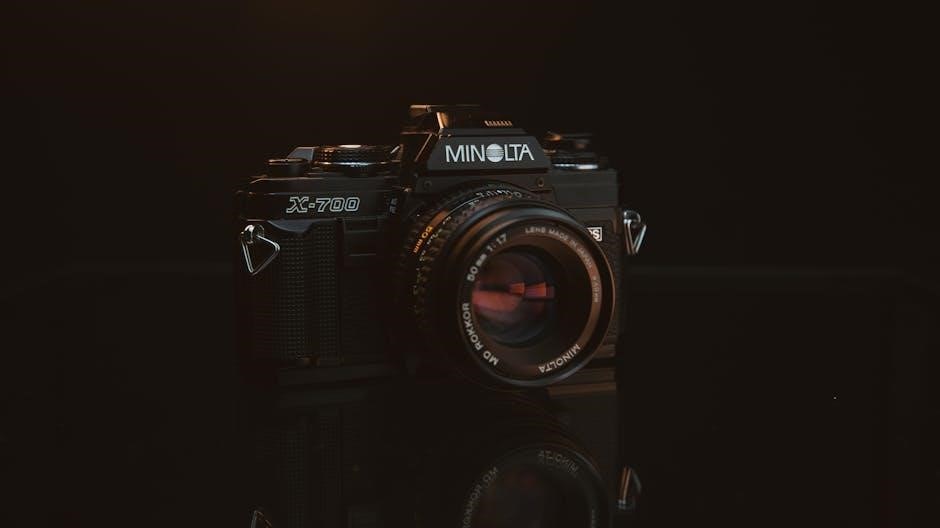
Troubleshooting Common Issues
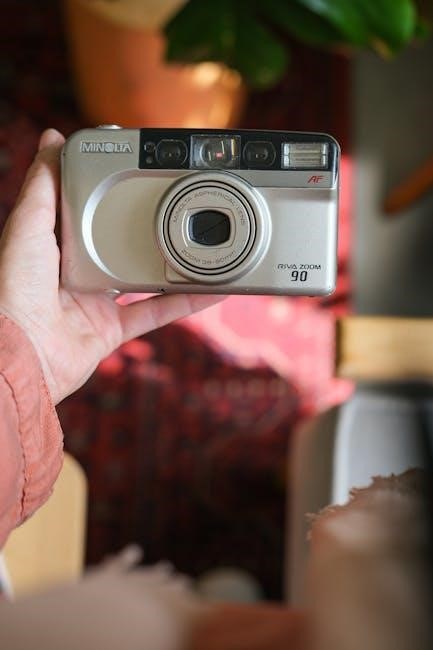
Address autofocus malfunctions by cleaning sensors and ensuring proper lens alignment․ Fix exposure errors by recalibrating metering modes․ Resolve battery issues by checking connections and replacing cells․ Regularly clean the mirror and shutter to prevent operational delays․ If problems persist‚ consult the service manual for advanced repair guidance or seek professional assistance to maintain optimal camera performance and functionality․
6․1 Resolving Autofocus Malfunctions
To address autofocus issues‚ clean the lens and camera sensors to remove dirt or debris․ Ensure the lens is properly aligned and securely attached․ If the problem persists‚ check the infrared focus beam for damage or misalignment․ Replace faulty components if necessary․ Reset the autofocus by disengaging the focus lock and restarting the camera․ Test the autofocus in different modes to identify specific malfunctions․ Consult the manual or a professional for advanced troubleshooting if issues remain unresolved․
6․2 Fixing Exposure and Metering Problems
Address exposure issues by resetting the camera to default settings or using manual mode․ Check for obstructions blocking the light meter and ensure proper lens aperture settings․ Clean the metering sensor gently with a soft cloth to remove dirt․ If overexposure persists‚ verify the film speed and ISO settings․ Replace the light meter or sensor if damaged․ Consult the manual for recalibration steps or seek professional assistance for complex repairs to restore accurate exposure control and metering functionality․
6․3 Addressing Power and Battery-Related Concerns
Check battery polarity and ensure proper installation to avoid short circuits․ Use compatible batteries (e․g․‚ CR2025 or SR44) and test their voltage with a battery tester․ Replace dead batteries promptly and check the camera’s battery indicator for accurate power levels․ If issues persist‚ reset the camera or consult the manual for power-saving mode adjustments․ Clean battery contacts with a soft cloth and ensure they are dry․ For recurring problems‚ refer to the troubleshooting guide or contact a professional for assistance to restore reliable power functionality․
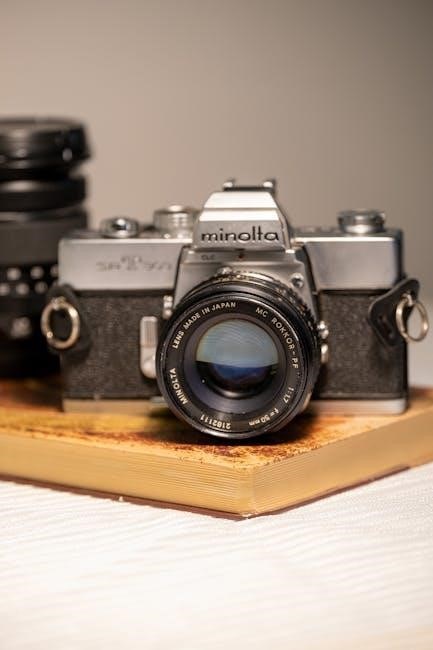
Accessories and Compatible Equipment
Explore compatible lenses‚ flash units‚ and other accessories to enhance your Minolta 7000 experience‚ ensuring optimal performance and versatility for various photography needs and scenarios․
7․1 Lenses and Their Compatibility
The Minolta 7000 is compatible with a wide range of lenses‚ including the Minolta AF A-mount series‚ ensuring versatility for diverse photography needs․ These lenses are designed to deliver sharp‚ high-quality images with excellent color accuracy and contrast․ From wide-angle to telephoto‚ the A-mount system offers extensive options for capturing stunning shots․ Additionally‚ the camera supports older Minolta manual-focus lenses with an adapter‚ providing backward compatibility and enhancing its appeal for photographers with existing lens collections․ Exploring these options can significantly enhance your creative possibilities․
7․2 Flash Units and External Lighting Solutions
The Minolta 7000 supports a variety of flash units‚ including the Minolta 2800AF and 5400HS‚ which integrate seamlessly with the camera’s TTL metering system for precise flash exposure․ These units offer features like bounce and swivel capabilities‚ enhancing lighting flexibility․ Additionally‚ the camera is compatible with third-party flash triggers and wireless systems‚ allowing for more creative off-camera lighting setups․ External lighting solutions‚ such as studio strobes‚ can also be connected via the camera’s sync terminal‚ further expanding its capabilities for professional-grade photography;
7․3 Other Accessories for Enhanced Functionality
Beyond lenses and flash units‚ the Minolta 7000 supports a range of accessories to enhance functionality․ Remote shutter releases minimize camera shake during exposures‚ while data backs enable time and date imprinting on photos․ Dedicated camera bags and cases protect the equipment‚ and lens cleaning kits ensure optimal optical performance․ Additionally‚ remote infrared controllers provide wireless control‚ and interchangeable viewfinders cater to different shooting preferences․ These accessories expand the camera’s versatility‚ making it adaptable to various photography needs and styles for both casual and professional use․
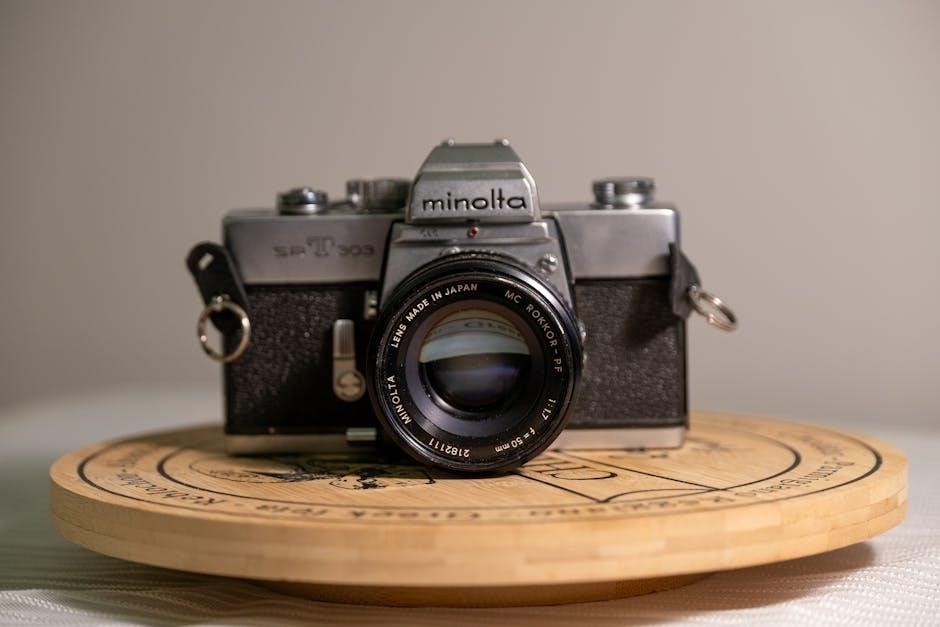
Maintenance and Care
Regular maintenance ensures the Minolta 7000’s longevity․ Clean the camera and lenses with soft cloths‚ store it in a dry place‚ and inspect for wear regularly․
8․1 Cleaning and Storing the Camera Properly
Regular cleaning and proper storage are essential for maintaining the Minolta 7000’s performance․ Use a soft‚ dry cloth to wipe the camera body and lens‚ avoiding harsh chemicals․ Store the camera in a cool‚ dry place‚ away from direct sunlight‚ to prevent moisture damage․ Consider using silica gel packets to absorb humidity․ Always attach the lens cap when not in use to protect the lens from dust and scratches․ For long-term storage‚ remove batteries to prevent corrosion․ Proper care ensures the camera remains functional and ready for use․
8․2 Regular Maintenance for Longevity
Regular maintenance is crucial to extend the life of your Minolta 7000․ Check the mirror and shutter mechanism periodically for dust and debris‚ as these can affect performance․ Inspect the shutter curtains for signs of wear or damage‚ and ensure all moving parts are well-lubricated․ Clean electrical contacts gently with a rubber eraser to maintain proper connectivity․ Avoid over-lubrication‚ as it may attract dust․ Schedule professional servicing every few years to address internal wear․ Consistent upkeep ensures the camera operates smoothly and maintains its reliability over time․
8․3 Tips for Preventing Common Wear and Tear
To prevent wear and tear on your Minolta 7000‚ always use a lens cap when the camera is not in use to protect the lens from scratches and dust․ Handle the camera by the body or strap to avoid unnecessary stress on the lens mount․ Avoid exposure to extreme temperatures or humidity‚ which can damage internal components․ Store the camera in a dry‚ padded case when not in use․ Regularly inspect and clean the tripod mount and other metallic parts to prevent corrosion․ These simple precautions will help maintain your camera’s condition for years of reliable use․
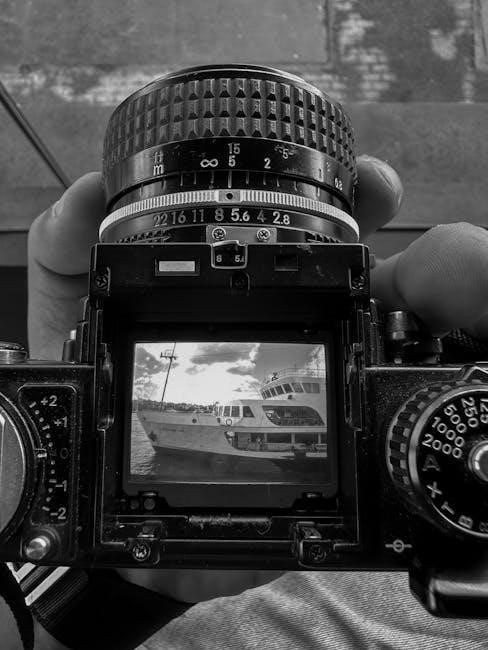
Downloading and Accessing the Manual
The Minolta 7000 manual can be downloaded from official camera forums‚ manufacturer websites‚ or trusted third-party archives․ Ensure the source is reliable for accurate information․
9․1 Sources for the Minolta 7000 Manual
The Minolta 7000 manual is available through various online sources‚ including official Minolta websites‚ third-party archives‚ and photography forums․ Websites like ManualsLib or ManualsOnline host PDF versions‚ while eBay and specialized camera forums often provide downloadable links․ Ensure the source is trusted to avoid malicious files․ Additionally‚ some vintage camera communities and Reddit groups share scanned copies for enthusiasts․ Always verify the file’s integrity before downloading to ensure it is complete and virus-free․
9․2 Instructions for PDF Download and Installation
To download the Minolta 7000 manual‚ visit trusted sources like ManualsLib or ManualsOnline․ Locate the PDF file and click the download link․ Save it to your device‚ ensuring the file is complete․ For installation‚ extract the PDF if zipped․ Open the file using a PDF viewer like Adobe Acrobat․ Verify the manual’s integrity by checking for all sections․ Avoid untrusted sources to prevent malware․ Once installed‚ review the manual to familiarize yourself with its content and organization․
9․3 Navigating the Digital Version of the Manual
Open the PDF manual using a compatible viewer like Adobe Acrobat․ Use bookmarks or the table of contents for quick access to sections․ Click on hyperlinks to jump to specific topics․ Utilize the search feature by pressing Ctrl+F to find keywords․ Adjust the view by zooming in/out or switching to full-screen mode․ Take notes or highlight text for reference․ Save bookmarks or annotations for future use․ Familiarize yourself with the layout to efficiently navigate and find information․ Ensure your viewer is updated for optimal performance․
10․1 Summary of Key Takeaways
The Minolta 7000 manual provides comprehensive guidance for optimal camera usage‚ covering essential features like autofocus‚ metering modes‚ and custom settings․ It emphasizes proper setup‚ maintenance‚ and troubleshooting to ensure longevity․ By following the manual‚ users can master advanced techniques and personalize their photography experience․ Regular care and understanding of compatible accessories are also highlighted to enhance functionality․ This guide serves as an invaluable resource for both beginners and experienced photographers seeking to maximize the camera’s potential․
10․2 Encouragement for Further Exploration
Exploring the Minolta 7000 manual further will unlock its full potential‚ offering insights into advanced photography techniques․ Experiment with metering modes‚ autofocus precision‚ and custom settings to refine your skills․ Discover how to pair the camera with compatible lenses‚ flashes‚ and accessories for enhanced creativity․ Continuous learning and experimentation will deepen your understanding‚ helping you capture stunning images with ease․ Embrace the manual as a lifelong guide‚ inspiring you to explore new photographic horizons and master the art of photography with confidence․
